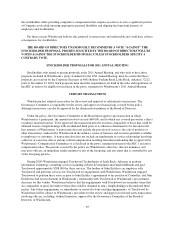Windstream 2009 Annual Report Download - page 52
Download and view the complete annual report
Please find page 52 of the 2009 Windstream annual report below. You can navigate through the pages in the report by either clicking on the pages listed below, or by using the keyword search tool below to find specific information within the annual report.The Company has established stock ownership guidelines for executive officers. The Chief Executive
Officer (“CEO”) is required to maintain beneficial ownership of shares at ten times base salary; the Chief
Financial Officer (“CFO”) and General Counsel at five times base salary; and three times base salary for all other
executive officers. Further, officers are required to hold for at least six months all shares received, net of tax
payment obligations, upon vesting of restricted stock or the exercise of stock options. Newly appointed executive
officers have a transition period of three years from their initial appointment.
We believe this policy does not go far enough to ensure that equity compensation builds executive
ownership, especially given the extended time period for compliance. We also view a retention requirement
approach as superior to a stock ownership guideline because a guideline loses effectiveness once it has been
satisfied.
We urge stockholders to vote for this proposal.
BOARD OF DIRECTORS’ STATEMENT
IN OPPOSITION TO THE STOCKHOLDER PROPOSAL
The Board of Directors has considered this proposal and believes its adoption is unnecessary and is not
desirable. The Board believes that its existing policies already address the objectives of the proposal and believes
that the proposal would undermine the effectiveness of the Company’s existing executive compensation
programs. Stock ownership is a fundamental element of the Company’s compensation program and provides an
essential source of incentives to our executives. The Board believes that the Company’s equity compensation
policies have been essential to attracting and retaining talented executives and in motivating them to manage
toward long term value for the Company’s stockholders.
The Company’s executive compensation program is carefully balanced to provide a competitive level of
at-risk and performance-based incentives through a combination of equity awards that includes performance-
based and time-based vesting of restricted stock. The use of equity awards demonstrates the Board of Directors’
belief that executive stock ownership aligns the executives’ interests with those of the stockholders by ensuring
that executives have an interest in the long-term performance of the Company and an investment in the future of
the Company. Consistent with this belief in the value and importance of equity compensation, the Committee has
established stock ownership guidelines for executives as outlined in detail in the “Stock Ownership Guidelines”
section in this Proxy Statement. The stock ownership guidelines were last revised in 2007 and have been in place
since Windstream’s inception. These guidelines impose robust ownership requirements on the executive officers.
When these guidelines are considered along with Windstream’s Clawback Policy which requires executive
officers to forfeit equity received from vested equity compensation awards under the conditions set forth in the
policy, the Board of Directors believes that the interests of discouraging excessive risk-taking and promoting
long-term, sustainable value creation are already more than adequately addressed by Windstream’s policies.
The Board of Directors believes that these existing programs have achieved the right balance between
providing executives with meaningful compensation in the form of equity awards and also ensuring that they
have an appropriate investment in the Company’s future. Adopting this proposal would constrain the
Committee’s ability to utilize significant at-risk equity components because a requirement to hold such awards
through termination of employment would mean that executives would not have access to a majority of the
equity component of compensation until two years after they retire or otherwise cease to be employed by the
Company. In addition, by requiring retention for a period of two years following termination of employment,
executives who have been successful in enhancing stockholder value may choose to leave the Company earlier
than they otherwise would if they are interested in retaining the value they have helped to create by selling any of
their shares.
The Board of Directors remains committed to the design and implementation of equity compensation
programs and stock ownership guidelines that best align the interests of the Company’s leadership with those of
48
























